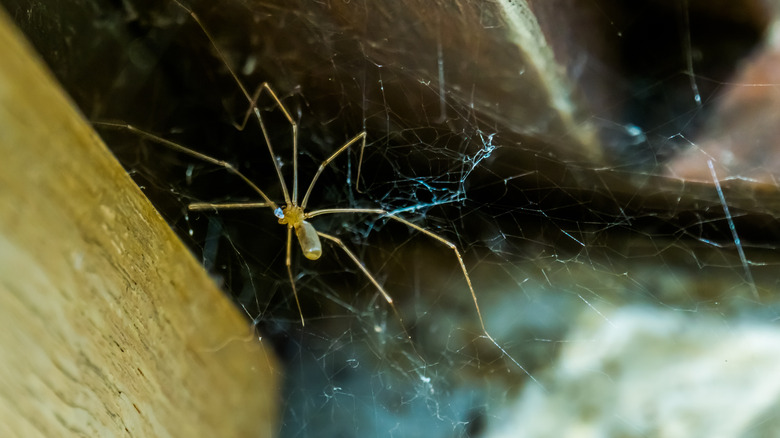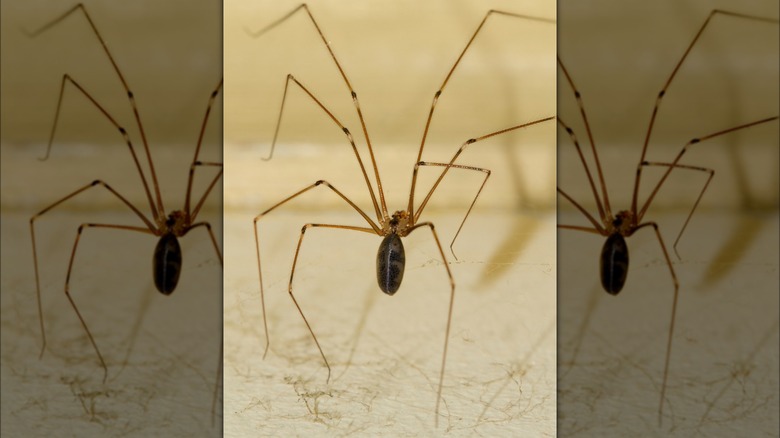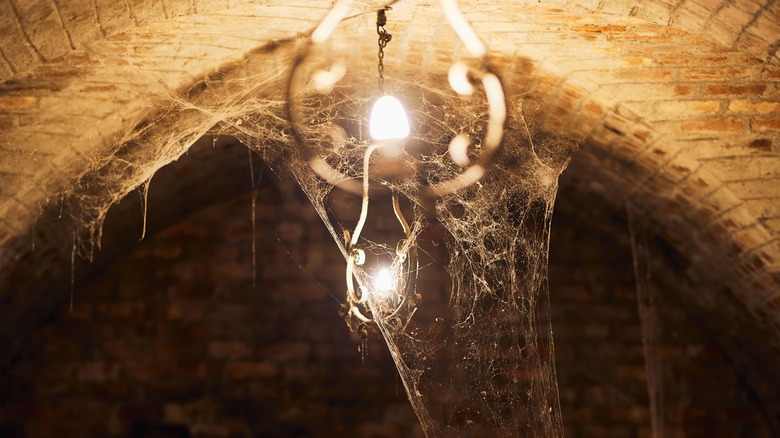How To Identify A Cellar Spider & If They Are Dangerous
Forever vacuuming messy spiderwebs from dark corners? A family of cellar spiders has likely taken up residence in your basement or is lurking in your garage. Don't panic — the knobbly-kneed, long-legged larikin spinning a web next to your basement furnace isn't a threat. In fact, cellar spiders are synanthropic, which means they're an undomesticated species commonly living harmoniously in domestic environments. This isn't a harmful invasion — they keep your home clear of pesky insect pests, including other spiders. At worst, their webs simply look unappealing. Plus, they're pretty small: You'll need to get out your magnifying glass for this ID!
You may call them daddy longlegs, but labeling them thus is confusing since harvestmen (an arachnid in a different order to spiders) and crane flies also go by the same common name. They're also sometimes confused with lookalike lampshade weavers and brown recluses, due to both having "fiddle" patterns on their backs. Scientists have so far identified 34 native and introduced species of cellar spiders in North America (via the University of Idaho), with the Pholcus phalangiodes, or long-bodied cellar spiders, among the most commonly spotted. Looks-wise, these spiders have spindly legs around four times as long as their bodies with dark nodes at the joints, an in-the-shell peanut-shaped abdomen, and, depending on the species, either six or eight eyes across two sets. They range in hue from pale yellow to tan to grey, and they grow to just over half an inch long — not including their made-for-the-catwalk legs.
The real thing
Unlike other eight-legged house friends (say, jumping spiders — which also happen to be predators of cellar spiders), cellar spiders tend to set up residence in a spot in your home and stay put. Usually, that's a dark corner in a room with little foot traffic. They quickly set to work building a chaotic web that's three-dimensional rather than flat. It's not sticky, either; insects that enter a maze-like cellar spider's web have difficulty finding their way out. They await prey in the center of this web, often hanging upside down with their "stomach" facing the ceiling. And if you look closely enough to see an egg sac, you won't see it on their abdomens or in silk webbing like some other spider species — female cellar spiders carry their cluster of tiny eggs in their jaws. Cellar spider mothers don't prey on their offspring, so a web may also host a clutch of babies until they disperse.
Another behavior unique to some cellar spider species is their tendency to spin rapidly in their webs when faced with danger. Some experts believe this may make them invisible to hungry predators or frighten them away; others speculate it could help the spiders capture their next meal — their gyration vibrates along the web's silks, forcing a visiting insect further into the structure.
Are they dangerous?
You've probably heard it claimed that daddy longlegs are one of Earth's most venomous creatures, but their fangs are too small or weak to penetrate the skin. It's a myth — whether you're talking cellar spiders or the other two bugs commonly called daddy longlegs. Cellar spiders can bite you, but they rarely do so, preferring instead to stay out of the way of us humans. They also produce venom, but there's no evidence it's toxic to mammals. At most, you'd feel a mild, short-lived sting, notes a 2019 paper published in Frontiers in Ecology and Evolution. Instead, they use their venom to subdue their next meal — ants, bees and wasps, moths, flies, mosquitoes, crane flies, and even other spiders — making them an excellent natural indoor pest control.
Their webs can get a bit unwieldy, especially when populations grow large; instead of eating old webs like other spiders, they build on old strands. When covered in dust, these disorganized constructions quickly become unsightly. Thankfully, indoor cellar spider webs are not as strong as those of their garden-dwelling counterparts due to less protein in the silk, as found in a 2017 National Academy Science Letters-published study. That, combined with the aforementioned lack of stickiness, means they're easy to clear away. No species of cellar spider is considered invasive, either, so you're not harming the local ecology if you encourage (or discourage) them. If you must, send cellar spiders running from your basement with natural remedies rather than chemical pesticides.


